Three Christmas hampers
by Mika Provata-CarloneStill pondering gifts for the smaller people in your life as the winter holidays loom? Here’s a selection of non-perishable treats for Discerning Young, Not Very Young and Definitely Older readers, featuring books that have been published, reissued or rediscovered in 2015, as well as one or two earlier favourites.
Hamper #1 – A Box of Delights
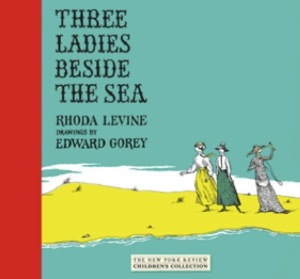 Three Ladies Beside the Sea by Rhoda Levine, illustrated by Edward Gorey (The New York Review Children’s Collection, 2010)
Three Ladies Beside the Sea by Rhoda Levine, illustrated by Edward Gorey (The New York Review Children’s Collection, 2010)
This is an older vintage, but perfect for reading right now for those who have not yet discovered it. Three Ladies Beside the Sea has crisp humour and soft sadness, is full of love, loss and an eternity of simple humanity. The words and images dance together charmingly, and their quirky, ethereal beauty cannot fail to enchant.
The question in the plot is quite simple:
Why is Alice up in a tree?
The answer can be discovered:
Edith and Catherine do.
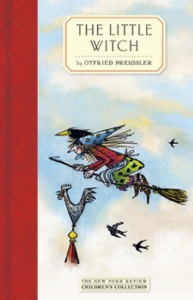 The Little Witch by Otfried Preussler, illustrated by Winnie Gebhardt-Gayler, translated by Anthea Bell (The New York Review Children’s Collection, 2015)
The Little Witch by Otfried Preussler, illustrated by Winnie Gebhardt-Gayler, translated by Anthea Bell (The New York Review Children’s Collection, 2015)
FIrst published in 1957, this is a serious book about a crucial question: What does it mean to be a witch? And how does a very young witch (barely 127 years old) get back on her feet – I mean of course on her broom – after she has been severely punished for wanting to join the grown-up witches before she has proven her mettle? Gloriously funny, whimsically illustrated, this is a book neither young nor old will want to put down.
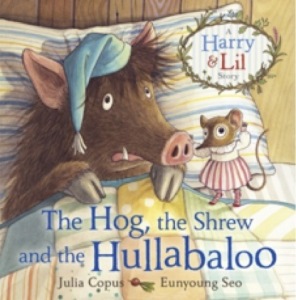 The Hog, the Shrew and the Hullabaloo by Julia Copus, illustrated by Eunyoung Seo (Faber, 2015)
The Hog, the Shrew and the Hullabaloo by Julia Copus, illustrated by Eunyoung Seo (Faber, 2015)
It was night in the village – a still, dark night –
and Harry the Hog was sleeping tight…
Lilting rhythms to enchant young ears and loosen eager tongues. Charming, funny and mysterious, the second Harry & Lil story is a delight to savour and a thrill to experience. CAUTION: Contains night-time noises of a dark (and not so dark) nature to be braved and deciphered.
 The Ride-by-Nights by Walter de la Mare (Faber, 2015)
The Ride-by-Nights by Walter de la Mare (Faber, 2015)
Up on their brooms the Witches stream,
Crooked and black in the crescent’s gleam.
One foot high, and one foot low,
Bearded, cloaked, and cowled, they go…
More poetry that will unfailingly mesmerise and intrigue, more mysteries to unravel, lots of tingles, oohs and aahs for the lucky ones who will unwrap this treasure by a true master-craftsman. Beautifully illustrated, a feast for the eyes and a treat for young hearts.
 Meet at the Ark at Eight! by Ulrich Hub, illustrated by Jorg Muhle (Pushkin Children’s, 2015)
Meet at the Ark at Eight! by Ulrich Hub, illustrated by Jorg Muhle (Pushkin Children’s, 2015)
How do you talk to children about God? For Ulrich Hub, a playwright turned novelist, the answer is simple: you write a story about how three penguins survived the Flood. Three, not two, which means one was a stowaway. A stowaway in an antediluvian suitcase, full of pluck, humour, oodles of charm and very serious philosophical ideas about just about everything. Will he be discovered? Will he survive? Will God the all-knowing know about him as well? And what about that celebrated dove? Will she be always solitary? Read to find out, read to be moved, read to laugh and share in enormous delight.
 Skimbleshanks the Railway Cat by T.S. Eliot, illustrated by Arthur Robins (Faber, 2015)
Skimbleshanks the Railway Cat by T.S. Eliot, illustrated by Arthur Robins (Faber, 2015)
This is a feline that surely needs no introduction and certainly deserves a solo edition from Faber, in a third picture-book pairing of an Old Possum cat and Robins’ charming drawings. An undyingly witty poem, an unashamedly cheeky cat, what more could a child want for Christmas?
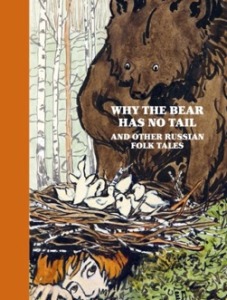 Why the Bear Has No Tail and other Russian folk tales by Elena Polenova, translated by Netta Peacock (Vassily Polenov Association, 2014)
Why the Bear Has No Tail and other Russian folk tales by Elena Polenova, translated by Netta Peacock (Vassily Polenov Association, 2014)
Sometimes we need the oldest tales to remind us how to relish stories. This is a beautifully illustrated collection of folk tales, retold and illustrated by Elena Polenova, a 19th-century painter whose works hang in the Tretyakov Gallery. Each has spirited wisdom and real enchantment, simplicity and great secrets. One gets lost in the images and in the words, enters a magical world of remembering and forgetfulness. A mellow, unhurried book, to read by a good fire.
Hamper #2 – All the Perfumes of Arabia
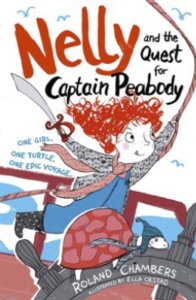 Nelly and the Quest for Captain Peabody by Roland Chambers (Oxford University Press, 2015)
Nelly and the Quest for Captain Peabody by Roland Chambers (Oxford University Press, 2015)
All parents make lists – they cannot help forgetting the unimportant as well as the important details of life. Usually they run “milk, flour, eggs, flowers, dog biscuits” or “MOT, dentist, new shoelaces for Nelly”. Well, in Nelly’s case, her dad’s list, left behind before he disappeared over a year ago, read:
1. Don’t forget N’s birthday. 2. Back in a year. 3. Don’t go native.
No red-haired little girl would ever put up with a dad who needs to remember her birthday (nor would a blond-haired or a brown-haired or a black-haired little girl either, for that matter). But a curious, intrepid and audaciously adventurous red-haired little girl, full of gusto and flair like Nelly, would certainly want to know what number 2 and 3 on the list were all about. Nelly sets out to find her dad, discovers more than she hoped for or expected, and certainly gives us a ribald story with absolutely endearing charm. A pirate story with chestfuls of laughter and good mischief.
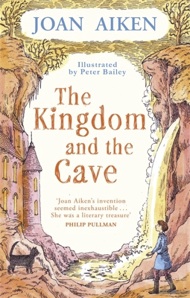 The Kingdom and the Cave by Joan Aiken, illustrated by Peter Bailey (Virago Modern Classics, 2015)
The Kingdom and the Cave by Joan Aiken, illustrated by Peter Bailey (Virago Modern Classics, 2015)
From T.S. Eliot to Aiken, the truth rings clear: you never own a cat, a cat owns you. This is Aiken’s first venture as a writer of children’s stories, a tale she told her younger brother in 1940, full of innocence and darkness. It shows Aiken’s rare flair for adventure and her particularly beautiful sense of the imagination. Her tale is about a young prince in a country about to be plunged in darkness and evil. Will the cat and its prince save the kingdom? There are echoes of the very best of children’s writing in Aiken’s story, echoes that create a company of enchantment. This is a book for young storytellers and story listeners, who, in Aitken’s words, still believe that writing is “the natural, indeed the only way to make a living.”
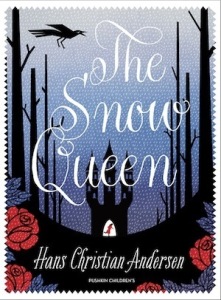 The Snow Queen by Hans Christian Andersen, translated by Misha Hoekstra, illustrated by Lucie Arnoux (Pushkin Children’s, 2015)
The Snow Queen by Hans Christian Andersen, translated by Misha Hoekstra, illustrated by Lucie Arnoux (Pushkin Children’s, 2015)
Great foreign writers sometimes endure the predicament of reaching their audiences in ‘versions’ –some of them disarmingly inventive and most disingenuously so. Andersen’s tales have withstood the many adaptations, modernisations, retellings: their themes and his spellbinding craft as a storyteller have transcended even the obscurest shadow-texts that have sprouted from them. Pushkin Press’ new translation gives us back Kay and Greda with fine, chilling drama. This is The Snow Queen for a new generation of readers – beautifully told and starkly illustrated.
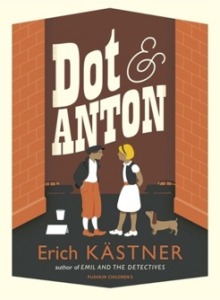 Dot and Anton by Erich Kästner, translated by Anthea Bell (Pushkin Children’s, 2015)
Dot and Anton by Erich Kästner, translated by Anthea Bell (Pushkin Children’s, 2015)
No Christmas would be Christmas without an Erich Kästner book. Kästner invariably touches our deepest recesses of humanity, fragility, humour, conscience, filling us with a nostalgic delight in everything relating to our years of childhood – whether sad or happy. He also bolsters us up with oodles of resolve to finally set things right. Like his indomitable characters, we too can change the world, even if we are little Dots or soft-spoken Lottes. As he often declared in his books, Kästner never tried to write happy stories – yet he and his characters stubbornly believe in happiness. Dot and Anton are just this sort of stubborn, determined young people: Dot is the whimsical daughter of a wealthy industrialist, who loves word-games and make-believe. She has everything, can conjure up everything with the sheer power of her twinkling imagination. Anton is the boy on the other side of the mirror: he has nothing and his mother is ill, he must find the means to support her. The two plot and plan, the plans go well at first, awry soon after, and glorious adventure ensues. This is a story about the magic spells in secret names, friendship, social divides and the melancholy truths of the real world. It is about dark, tough adversaries and plump cooks, darling fathers and rather crisp mothers – also fragile, gentle, precious mothers. It is a tale told with contagious humour and even more infectious humanity, a tale for every boy with a big resolution and every girl with millions of stories to tell.
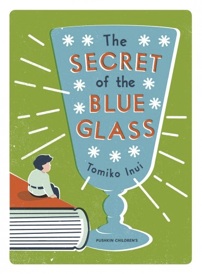 The Secret of the Blue Glass by Tomiko Inui, translated by Ginny Tapley Takemori (Pushkin Children’s, 2015)
The Secret of the Blue Glass by Tomiko Inui, translated by Ginny Tapley Takemori (Pushkin Children’s, 2015)
Only French and Greek children could read Tomiko Inui’s utterly absorbing story in translation until now. This is the first of Inui’s works to appear in English, and Ginny Tapley Takemori captures beautifully all the delicate hues and stark insights of the original. The Secret of the Blue Glass tells the story of two families: a Japanese family of long tradition and standing, with a particular love for books, culture, ideas across borders that can bring people and nations together, and a family of Little People who had been brought to Japan by an English nanny many years ago in a hamper, and are now stranded because of the war. Protecting them becomes an act of resistance and defiance – or treason – and their fate is intertwined with the ideological and national vicissitudes of Japan, its catastrophic choices, and its course through military dictatorship and human trauma – to defeat, and a final resolution. Here too children are evacuated to the countryside, families are torn apart by war but also by conflicting loyalties in the world of humans; while in the more mythical world of the Little People, animals, birds and local spirits mingle in search of truth, trust and safety. At the centre of the story is the Blue Glass with its hypnotic translucence, a symbol of serenity, a reminder of another world and a token of humanity: humans must provide one glassful of milk to the Little People every day – or else they will die. This is one of the most extraordinary tales of the 20th century, full of echoes and new visions.
 From the Mixed-Up Files of Mrs Basil E. Frankweiler by E.L. Konigsburg (Pushkin Children’s, 2015)
From the Mixed-Up Files of Mrs Basil E. Frankweiler by E.L. Konigsburg (Pushkin Children’s, 2015)
An eccentric, exquisitely elegant and wealthy old woman who knows exactly what she wants; a tired lawyer who has missed the point in life trying to make a living; two unappreciated children with a few dollars between them and a yearning to run away – but only to somewhere really nice. A priceless statue by Michelangelo sold for a pittance and a secret story behind it, a museum that becomes a home and a story that is exchanged for another – this is the utterly engrossing mix of ingredients of Konigsburg’s story, which has been a staunch favourite of American children since its first publication in 1967. It is a story about older sisters and younger brothers (and what they are good for), art and life, humour and sadness, loneliness and good company, about all that matters for the young and for the old. A story about finding new paths and retracing old ones, this is a book to share and especially keep close to heart.
Hamper #3: A New Curiosity Shop
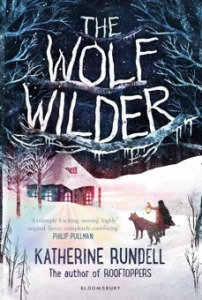 The Wolf Wilder by Katherine Rundell, illustrated by Gelrev Ongbico (Bloomsbury, 2015)
The Wolf Wilder by Katherine Rundell, illustrated by Gelrev Ongbico (Bloomsbury, 2015)
Did you know that Peter the Great had seven wolves, “all as white as snow”? Or that killing a wolf brings bad luck? “Life begins to disappear,” according to Rundell’s introduction, and this is a book about the disappearing world of stories as large as life. It is about snow and fear, courage and legend one hundred years ago. It is about horses that “wear plumes like ballerinas” and a “dark and stormy girl” who wants to wear bear skins and be a wolf wilder, someone who un-tames wolves so they may return to nature. The Wolf Wilder is especially about history, about men as much as it is about wolves, and especially about men who are as wolves to their fellow men. This is a haunting and enchanting book that brings readers closer to the most chilling questions – with wisdom, steadiness and the warmth of great friendships.
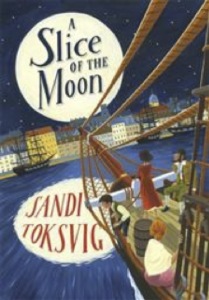 A Slice of the Moon by Sandi Toksvig (Doubleday, 2015)
A Slice of the Moon by Sandi Toksvig (Doubleday, 2015)
A deeply sensitive, flowingly written account of economic migration at the time of the Irish potato famine, this is a gripping tale of empathy, full of sadness and excitement. It is a book about dreams and nightmares, about what is too little, too much or just enough. The echoes of all that is happening outside the covers of this book are strong and unmistakable, and this is a story that mesmerises as fiction and facilitates understanding as an allegory.
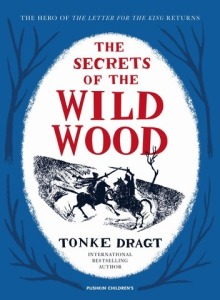 The Secrets of the Wild Wood by Tonke Dragt, translated by Laura Watkinson (Pushkin Children’s, 2015)
The Secrets of the Wild Wood by Tonke Dragt, translated by Laura Watkinson (Pushkin Children’s, 2015)
If you have read Letter for the King, you will have to exert serious self-control not to take The Secrets of the Wild Wood out of your stocking before you are supposed to. And if, for some inexplicable reason, you have not yet discovered the fairy-tale world of Tonke Dragt, then you are in for the most delicious double treat. Dragt believed that her books belonged in the English imagination, the English landscape and history. Yet she brings to that imagination elements quite unique, like the fragility and courage that became part of who she was as a person and a writer as a result of her imprisonment in a Japanese camp during the war, which she experienced as a child in the West Indies. Riveting adventure and delicate sensitivity is Dragt’s unique voice, and this is definitely a book for Christmas – and for an entire life.
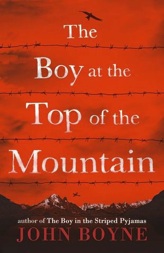 The Boy at the Top of the Mountain by John Boyne (Doubleday, 2015)
The Boy at the Top of the Mountain by John Boyne (Doubleday, 2015)
John Boyne is like Athena’s shield: he allows us to look at the Gorgons of history, making us experience their full monstrosity and horror without turning into stone. Instead, he makes us think, feel and resolve. In The Boy at the Top of the Mountain Boyne explores the thrill of evil, the “excitement of brutality”, as he sets his storyline one more time in the Second World War, this time extending its threads to Berghof, Hitler’s mountain retreat and the heart of Nazi idolatry, and as far beyond as France and Britain. French-German and orphaned, Pierrot/Peter runs his finger across the map of Europe early in the story, full of nostalgia for the home and parents he has lost, and something else: a desire for power, for the ‘charisma’ of domination. Boyne’s book is not so much about what we would do if we were in his place, but rather about how easily desirable his place appeared to him at the time. As in The Boy in the Striped Pyjamas, blindness follows insight, dilemmas become motivations, and unavoidable courses of action are revealed as original intentions. Pierrot/Peter at the end of his journey realises he is responsible not for individual acts but for everything that has happened – also that “time might move on, but the ideas of some people never would”, as deniers of the horrors of Nazism seemed calmer in their conscience even as more horrors were revealed. Once more, at the heart of the story is a friendship – between Pierrot/Peter and his Jewish neighbour in Paris, Ashel. Both survive the war, one with the impossible memory of guilt, the other with the trauma of loss and remembrance. Pierrot/Peter seeks out Ashel in Paris, and the last words of the novel are “let us begin”. Only Anna Gmeyner’s Manja has addressed the impact of Nazism on children with such sharp empathy and through such a powerful plot.
 Cue for Treason by Geoffrey Trease (Puffin, 2015)
Cue for Treason by Geoffrey Trease (Puffin, 2015)
More history, this time heroic, Elizabethan and full of scheming, treachery and intrigue. Two boys (one is actually a girl), a few misdemeanours against mighty lords, an escape in a coffin followed by an unsuccessful audition with Burbage, then a fine season on Shakespeare’s stage. Stolen manuscripts and secret codes, forays across England, chases and mighty pursuits that lead to an audience with the Queen – and a very happy wedding. Fortunes and order are restored in this spirited adventure, a classic from the ’40s, and not to be missed.
 The Gauntlet by Ronald Welch (Oxford University Press, 2015)
The Gauntlet by Ronald Welch (Oxford University Press, 2015)
Never pick up an iron glove if you happen to stumble upon it on a beach in Wales. At least not unless you want to find yourself in medieval England, in the company of knights, jousting for your life – and feasting in grand halls. You will be fighting in the siege of Carreg Cennen Castle, learning falconry and archery, walking down the silent passages of abbeys, and you will certainly not be called Peter Staunton any more, but will bear a name, Peter de Blois, that was the stuff of legend (or perhaps just dreams?) Read to find out more, and also to relish pure imaginative whimsy. A much-loved classic timeslip story, produced in a ‘heritage’ edition featuring the cover and illustrations from the 1951 original to delight a new generation of readers.
 The Door That Led to Where by Sally Gardner (Hot Key Books, 2015)
The Door That Led to Where by Sally Gardner (Hot Key Books, 2015)
Mums don’t come under the best of light in this ingenious twist on the theme of time travel. AJ’s mother, Mrs Flynn, is affectionately known to her son as ‘the monster’ or ‘the reptile’, yet she cantankerously seems to care enough for him to secure him a job with a law firm after he fails all his GCSEs but one – English, A*. AJ enjoys allusions to reptiles, modern or Jurassic, and Mr Black, the clerk AJ will be working for, likes references to Dickens, so AJ is hired on the strength of The Pickwick Papers and Nicholas Nickleby. Once in that venerable institution, AJ will stumble upon a key that will take him back to a world of more determined monsters and sharp-tongued reptiles, 19th-century Clerkenwell. He will need to solve a murder, fathom puzzles of love, build and hold on to friendships. Also return to his own place and time. But will he want to? A dark but expertly executed thrill.
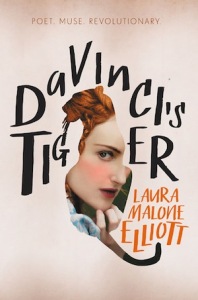 Da Vinci’s Tiger by Laura Marlowe Elliott (HarperCollins, 2015)
Da Vinci’s Tiger by Laura Marlowe Elliott (HarperCollins, 2015)
This time the journey is inside a painting and back through art into the heart of a real life. L.M. Elliott gives us the story of Ginevra de’ Benci, whose portrait is the only Leonardo in public view in America.
Leonardo’s portrait was an act of revolution in aesthetics, and also as regards the relationship between art and its viewers as well as the place and role of women – their presence beyond the silence of an introverted interior to the straight gaze of an outside space. For the first time, the impersonal becomes fierily personal, the hidden revealed – Leonardo’s stated intent was to produce paintings as lifelike as to be true objects of inflamed desire. Ginevra de’ Benci could not have been a better chosen sitter: the daughter of a wealthy family, a poet of great culture and even greater allure, she seems to have attracted every man worthy of mention in Renaissance Italy, from financial magnates and ambassadors to Lorenzo de’ Medici. Elliott weaves a brilliant tapestry of Ginevra’s life, and lends a voice to that first three-quarter portrait of art history. No longer looking away in profile, Ginevra looks at us and urges us to pore into her life inside and especially outside the house – the enthralling world of patrons, artists, philosophers and poets of the Medici’s Florence – and to feel the frustration of women of talent in a world of men.
 The Fox and the Star by Coralie Bickford-Smith (Particular Books, 2015)
The Fox and the Star by Coralie Bickford-Smith (Particular Books, 2015)
Once there was a Fox who lived in a deep, dense forest. For as long as Fox could remember, his only friend had been Star, who lit the forest paths each night. But then one night Star was not there, and Fox had to face the forest all alone.
What do you do when you lose the star that guides you? Dreamy and stunning artwork playing with darkness and light, intertwining sadness and joy, guides the fox to a place of remembrance, reunion and redemption. A truly beautiful story enchantingly told and illustrated, inspired by William Blake’s ‘Eternity’ and the graphic work of William Morris.
Mika Provata-Carlone is an independent scholar, translator, editor and illustrator, and a contributing editor to Bookanista. She has a doctorate from Princeton University and lives and works in London.

